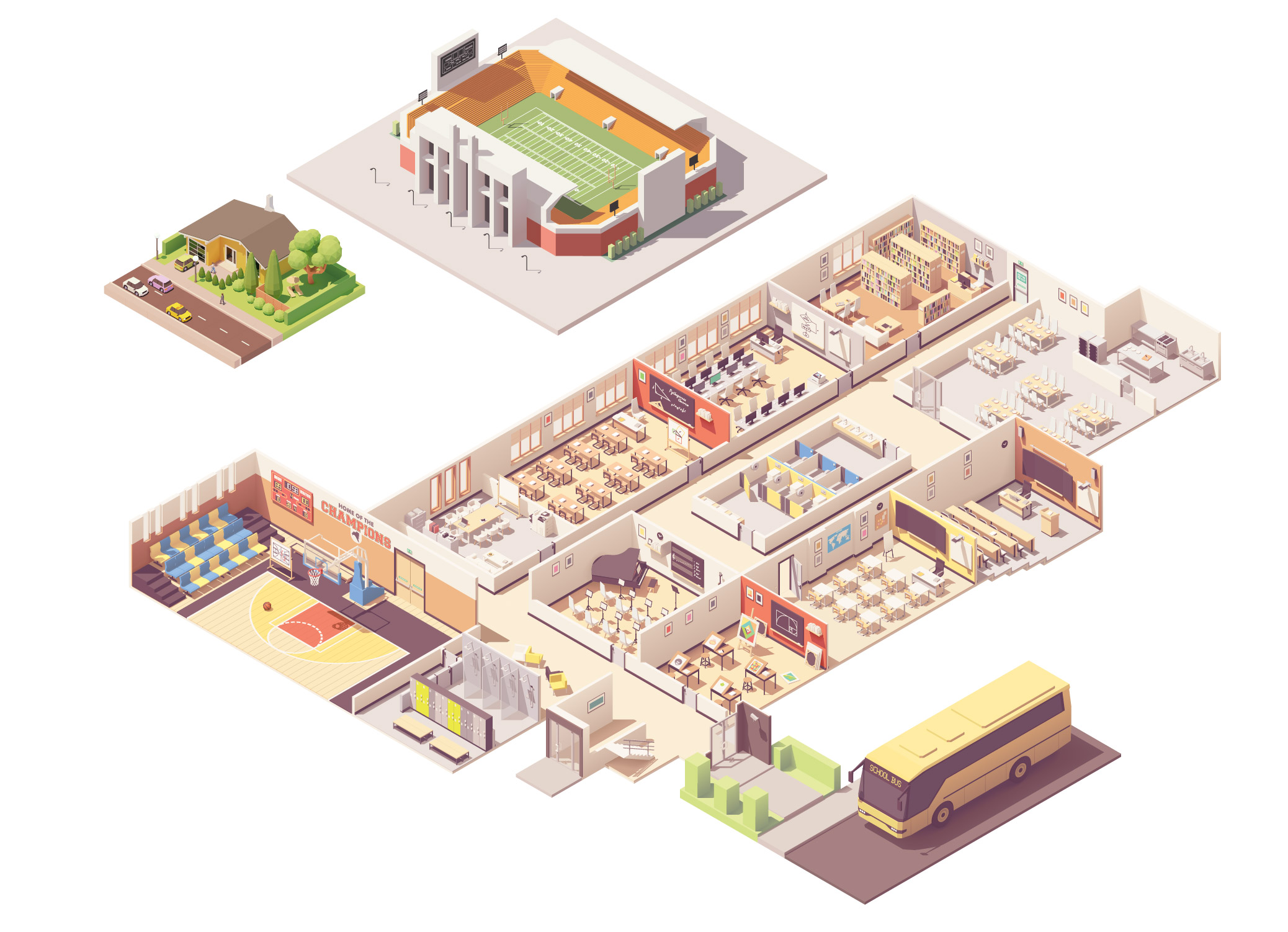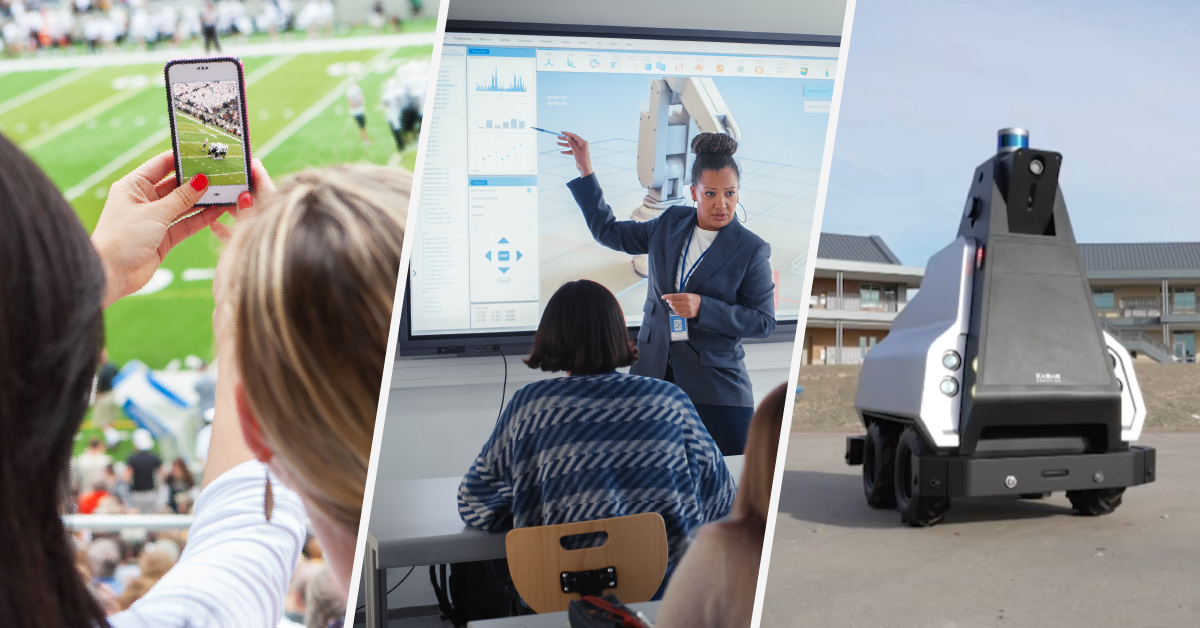Modern higher education institutions rely on technology in a multitude of ways. Twenty-first century colleges and universities need to keep pace with the latest technologies not only to create new opportunities for unprecedented learning experiences, but also in order to optimize campus operations.
State-of-the-art technologies such as private 5G networking, autonomous robotics and simultaneous datacasting are revolutionizing the educational experience by enabling the truly connected campus. But exactly how is connectivity transforming higher education?
Transforming Today’s Campus
A connected campus allows the integration of technology into every aspect of operations and curriculum, creating a range of educational benefits. Improvements include access to online educational resources, increased productivity, security and collaboration, as well as hands-on instruction in advanced technologies such as augmented reality (AR) and virtual reality (VR).
Seamless mobile connectivity is essential for digital-native students who expect reliable broadband service across the campus, from the dorm to the classroom. Moreover, higher education faculty and facilities personnel rely on pervasive communications to provide essential services, enabling productivity, security and peace of mind.

Smart Classroom
Transform traditional classrooms into dynamic and interactive learning environments with seamless access to online educational resources, virtual classrooms, and interactive learning platforms.
Education Technology
Support innovative technology that takes students beyond the textbook with tablets, smartboards, augmented reality, virtual reality, game learning, and 3D printing.
Library Services
Reinvent your library into a vibrant hub of learning, innovation and classroom engagement with virtual access to academic journals, multimedia content, and immersive learning experiences.
Remote Learning
Physical attendance is no longer mandatory with remote learning options providing video participation, digital textbooks and online project collaboration.
Athletics
Delight sports fans with a connected experience, support security staff communications, and enable mobile concessions and ticket transactions.
Safety & Security
Protect your students and staff with remote access control and video surveillance that provides critical real-time data in dangerous situations so first responders have situational awareness.
Classroom Communications
Ensure everyone stays informed by delivering educational content, homework assignments and announcements directly to your teachers and students.
Parent-Teacher Engagement
Foster a collaborative community of parents and teachers by using connectivity solutions to keep everyone informed with virtual meetings, important announcements and event live streams.
Even today’s athletics programs can vastly enhance effectiveness by embracing technology. To ensure compliance with all relevant department, district and state requirements, athletic directors can leverage mobile connectivity to the cloud to reliably deliver a variety of required forms and notifications. And with the significant impact that athletics have on school budgets, it’s hard to overstate the importance of attracting fans by creating the connected stadium experience, or leveraging advanced data analytics for competitive advantage on the field.
However, athletic events held in stadiums and remote athletic fields can present considerable connectivity challenges for universities. Seamless communications for security staff, concessions transactions and ticket management all rely on consistent and reliable connectivity, which can be challenging with traditional Wi-Fi access points. Moreover, cost-effective, high-performance technology is needed to address requirements for television broadcasting, including instant replay and mobile camera capture, as well as conference requirements for sideline technology such as tablets and audio communication.
The Ideal Educational Experience
A reliable and robust wireless infrastructure is the cornerstone of the connected campus. However, mobile traffic surges can easily overload Wi-Fi networks, especially during large events when reliable communications are paramount for student and visitor safety.
On the other hand, private networks deliver secure and reliable broadband connectivity with dedicated bandwidth and scalable capacity. In fact, a private network offers cost-effective connectivity with greater security, reliability and control over network management. Plus, the latest private LTE/5G network technology also empowers new capabilities that further enhance the campus experience, such as interactive smartboards, LED signage, environmental controls and facial recognition technology.
With these new capabilities, faculty members have ready access to the latest digital tools that enrich instructional approaches, disciplines and learning goals. For example, datacasting provides a paradigm shift in how content is delivered, using traditional television broadcast signals and ATSC 3.0 technology to broadcast to receivers like tablets, laptops and LED signs in areas with limited connectivity.
By providing access to interactive lessons, video lectures and other multimedia content, datacasting ensures students and teachers have access to high-quality materials. In addition to sharing lessons and educational content, datacasting also allows schools to communicate with students, teachers and parents by simultaneously broadcasting messages to cell phones and other mobile devices, informing relevant audiences about important announcements and emergency notifications.
Mission-Critical Security
Higher education institutions balance many responsibilities, but chief among them is ensuring the safety and security of students, faculty, staff and visitors at all times. Reliable connectivity provides the basic infrastructure required to create an efficient, modular security system that meets specific campus needs, whether that means private networks, datacasting or fixed wireless access technologies.
As security solutions evolve, pervasive connectivity provides the flexible foundation needed for a range of security solutions to deliver peace of mind. Solutions might include real-time access control with automated doors, surveillance cameras for monitoring and recording criminal activity, automated or motion-sensitive lighting, and environmental sensors to detect hazardous situations such as gas or water leaks.
The emergence of autonomous security robot technology, in particular, is quickly becoming a preferred solution to protect people and property across campuses worldwide. Autonomous or remote-controlled robots can patrol large areas to provide an extra level of security. And security personnel can access more accurate information in real-time with live feedback from the robot’s cameras.
Building the Connected Campus
Higher education continues to evolve, and the connected campus experience is more critical than ever. By designing, building and managing high-speed and highly reliable connectivity solutions, leading colleges and universities are leveraging the latest technologies to deliver a world-class educational experience, while also improving operational efficiency and security.
An industry leader in wireless solutions, Trilogy NextGen specializes in designing and building the infrastructure needed to transform your traditional campus into a modern, connected campus. Connectivity solutions from Trilogy NextGen offer diverse, flexible and cost-effective means to enhance security and operational efficiency, such as a campus-wide private 5G network with the Nokia Digital Automation Cloud (DAC) Private Wireless Compact.
The Nokia DAC PW Compact solution is a high-performance, end-to-end private network and edge computing platform that offers reliable connectivity, security and radio performance. This compact solution was specifically designed to meet the connectivity needs of small and mid-sized sites, featuring easy plug-and-play deployment while reducing energy consumption versus Wi-Fi networks.
To learn more about how to revolutionize the connected campus, contact Trilogy NextGen for a consultation.

